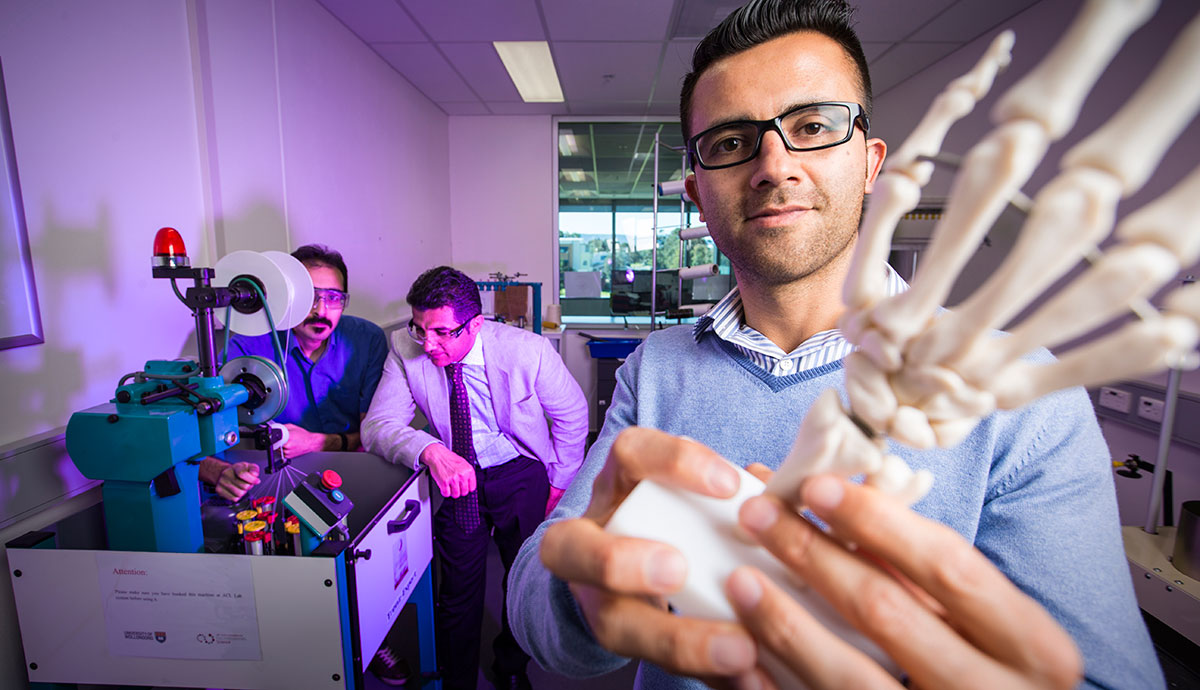June 4, 2015
Finger trap hits the right nerve in winning Pitch
Spinning yarns and ancient practical jokes have inspired a way to heal diseased and damaged nerves.
The team of PhD students Rodrigo Lozano, Syamak Farajikhah and mentor Dr Javad Foroughi (pictured above) entered the nerve conduit concept in the UOW Pitch 2014 competition, where they won the Postgraduate category and a $6,000 prize to help further the innovation.
The idea, developed in the labs at the UOW’s Intelligent Polymer Research Institute (IPRI), involves braiding biocompatible textiles into a cylindrical shape, or conduit.
| UOW PITCH 2015 calling bright minds |
|---|
| Innovative minds have an opportunity to turn their ideas into reality and share in $40,000 worth of prizes as well as iAccelerate scholarships. Entries close 10 July for the UOW Pitch 2015 competition, which is helping staff and students turn their innovative into reality while fostering a culture of innovation and entrepreneurship at UOW. For information and entry details visit the UOW Pitch 2015 webpage. |
The textile conduit is implanted at the site of the damaged nerve to guide re-growth and re-attachment of the severed nerve. The porous weave can be embedded with growth factors to stimulate the body’s repair process.
Nerve injuries can occur through trauma, cancer or congenital diseases. Trauma from vehicle accidents, falls, contact sports and violence are the most common causes.
The severity and consequences of the trauma depends on the location of the injury. Damage to the spinal cord can cause paraplegia or quadriplegia, while damage near the spine can lead to loss of sensation or movement of specific muscles.
Health data shows there are more than 350 new cases of spinal cord injury in Australia every year. The Spinal Cord Injury Network estimates the total cost of spinal cord injuries in Australia is about $2 billion annually.
There are two current solutions for nerve injury. The first procedure involves grafting or stitching sections of nerve taken from elsewhere in the body. The procedure is time consuming, increases patient risk and often results in limited restoration of nerve function.
An alternative treatment involves inserting implants made of soft plastic or hard gel-based materials to act as conduits to guide nerve regeneration. This procedure is limited to injuries smaller than 3-centimetres long and the implant can move out of position.
PhD student Rodrigo Lozano said the Chinese finger trap, a children’s toy that traps unsuspecting fingers in the ends of a bamboo or paper cylinder, inspired the concept for the next generation textile scaffolds for nerve reconstruction.
As the victim tries the pull their finger free, the trap tightens. Compressing the cylinder releases its grip.
“I saw researchers working on braided structures in the lab and the pattern reminded me of the Chinese finger trap,” Rodrigo said. “At the moment when an nerve implant is inserted it can move so the surgeon has to stitch it in place and this can cause more trauma or damage to the nerve.
“The idea is that much like a finger trap, the implant will be compressed to be put in place, then when it releases and expands it grabs and gently but securely holds the nerve endings, without the need for sutures.”
IPRI Research Fellow Dr Javad Foroughi said the conduit can be easily fabricated and modified using existing textiles machinery.
With Australian Research Council Discovery Early Career Researcher Award (DECRA) funding Dr Foroughi is developing novel 3D textiles that can be used for biomedical applications and smart fabrics for wearable technology.
“There is no limit to the length of structure we can make and the by adjusting the weave pattern we can alter its porosity, which helps with making it compatible with the human body,” he said.
“Moreover, the 3D scaffold can electrically stimulate cells and can be loaded with drugs and growth factors to foster nerve and tissue growth.”
A biodegradable polymer was chosen and the prototype has been sent to St Vincent’s hospital in Melbourne for cell culturing and further biological testing.
